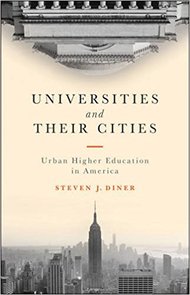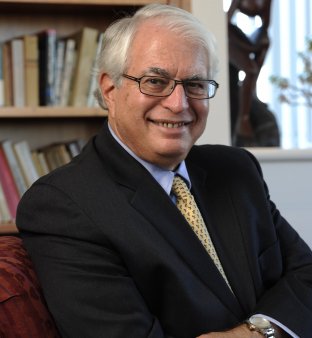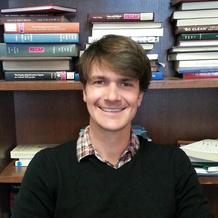Universities and their Cities: An Interview with Steven J. Diner
Today on Gotham, editor Nick Juravich sits down with Steven J. Diner, the former chancellor of Rutgers University-Newark, to speak about his new book, Universities and their Cities: Urban Higher Education in America.
I usually start by asking how authors came to their topic, but in your case the connection is very clear. So, to phrase the question in a different way, what were your goals for this project? Who do you hope is reading the book, and what do you hope they take away from it?
In the latter part of my ten years as chancellor of Rutgers-Newark, I began thinking casually about returning to research when I left administration. I knew that most former chancellors or presidents rarely undertake scholarship after leaving administration, but I wanted to be different. I had written about universities and cities since my days as a doctoral student at the University of Chicago. I had taught urban studies for thirteen years at the University of the District of Columbia (UDC), which proclaimed itself the nation’s first urban land-grant college. At UDC I directed an NEH-founded program to provide historical research on public education and housing in Washington to be used by policy makers, and presented the research to the mayor and other city officials. I then taught and held administrative positions at George Mason University, an institution deeply committed at that time to serving as an anchor for the rapidly expanding suburban community of northern Virginia. In 1998, I came to Rutgers University-Newark as arts & sciences dean with the goal of taking fullest advantage in teaching, research and service of its location in what was then considered one of the most troubled cities in America. And I served as president of the Coalition of Urban and Metropolitan Universities. So I thought that when I did return to scholarship I would write something on the history of urban universities.
A longtime friend and leading historian of American higher education, the late NYU professor Harold Wechsler, suggested that I begin by looking at the annual meetings and publications of the Association of Urban Universities (AUU), founded in 1914. I was surprised to learn how the leaders of universities in cities articulated profoundly negative views about the impact of urban life on college students. This was quite different from my research on the early years of the University of Chicago, where the founding president William Rainey Harper embraced the city as a rich resource to build a new entity, the American research university. My work on the AUU led me to focus my research on how higher education and civic leaders viewed urban higher education.
Well, that brings me to a process question (we like to ask these). You've been studying the history of higher education since your first book, A City and Its Universities (1989). How has the field evolved?
When I researched the ways universities engaged with public policy issues in Progressive era Chicago, almost nothing had been written specifically about the history of city-university relationships. The issue received modest attention in historical writing on the emergence of academic disciplines and research universities. Since publication of my book on Chicago in 1980, much has been written on the history of higher education. But historians did not publish very much about the development of urban colleges and their relationship to cities until about fifteen years ago. Among these more recent histories are Margaret Pugh O’Mara, Cities of Knowledge: Cold War Science and the Search for the Next Silicon Valley (2005), John Lewis Recchuiti, Civic Engagement: Social Science and Progressive Era Reform in New York City 2007) and Sharon Harr, The City as Campus: Urban Higher Education in Chicago (2011). A number of institutional histories published in recent years also examine the relationship with the city, and scholars have written a lot about university relationships with their neighborhoods and their role in gentrification.
And tell us about the source base for the book, particularly for our New York City readership. What kind of records are available in the metro region to historians of higher ed?
Since academicians write a lot, I have looked at numerous articles by administrators and professors about the city and in particular about issues like open enrollment in New York. The records of higher education organizations are extremely useful. Although the book is not based on case studies of specific institutions, I found the archives of City College, Hunter College, Columbia and UCLA very useful. The Rockefeller Archives Center in Tarrytown houses the records of the Ford Foundation. Columbia University has the records of the Carnegie Corporation. The Hoover Institution archives in Palo Alto contain the records of national higher education organizations, including the American Council on Education and Association of Urban Universities.
Okay, moving on to content. In the introduction you write about the evolving meaning of the term "urban university," and offer a capacious definition — one that includes elite institutions aspiring to global influence which happen to be located in cities, as well as public institutions built expressly to serve the people of these cities. Columbia is an example of the first, with a particularly fraught history of conflict with its surrounding neighborhood. Gotham is based at CUNY, the largest example of the second sort. These are very different kinds of institutions, but you still find it valuable to study them together. What kinds of things unite them, beyond location? What can they learn from one another? And what do we gain from this approach?
Given my book on Chicago, I was stunned to learn about the widely held view that urban universities were defined by a student body made up largely of local students from low or modest income families. Discovering the low status if not pejorative view of the term “urban university” made it all the more important for me to study the range of institutions in cities. Irrespective of their students’ socio-economic backgrounds, cities provide enormous resources for teaching, faculty and student research and community engagement. Colleges in cities can learn from each other about ways to use the city most effectively for teaching in a wide variety of disciplines. They can also share with each other the opportunities, rewards and perils of undertaking research on local public policy issues.
However, there is a striking difference between residential and commuter institutions. The opportunities for resident students to engage with the city are much greater, and commuter colleges normally do not have the same impact on their immediate neighborhoods as schools with large numbers of students living on campus or nearby. Many urban commuter institutions are now building residence halls to enable lower-income students to get the 24/7 college experience. At Rutgers University-Newark, there was significant opposition by the central administration in New Brunswick to student housing. Some argued that no one would want to live in a city plagued with violence, crime and poverty. But campus housing has been very successful and is growing. And I secured a large corporate donation to enable low-income Newark residents to live on campus. This program has been spectacularly successful and greatly expanded by my successor.
That sets me up for my next question. As you note toward the end of the book, the "urban crisis" narrative has undergone a remarkable reversal in the past decade or so. I actually have a trio of questions here. First, what role have universities played in the “urban renaissance”?
There are a many reasons for the dramatic revitalization of some American cities. “Eds and meds” certainly play a role, and increasingly higher education institutions see themselves as anchor institutions which help attract businesses that benefit from the expertise of faculty in the sciences, technology, the performing and visual arts, economics and many other disciplines. In Newark, the growing number of students living on or near campus has spurred significant retail, commercial and residential development on long vacant property. In many places, however, the university has played a role, sometimes intentional and sometimes not, in stimulating construction of new upper middle-class housing on property occupied by low-income neighborhood residents. Universities today should work with city government and with developers to insure that a significant portion of new neighborhood housing is reserved for low-income residents, especially those whose neighborhood residences are eliminated.
Second, how does this changing narrative affect the larger world of higher education? As you note, higher education had a deep rural bias in the 19th century, which continued well into the twentieth (reinforced, perhaps, by the rise of a persistent "urban crisis"). Today, however, most college students are in cities, and many rural colleges are struggling. What does this mean for the future of higher education?
As universities increasingly incorporate city life into the college experience, college education is now focused substantially on experiential learning and on inculcating the social value of civic engagement. With overall higher education enrollments declining and the popularity of cities increasing, small town and rural private institutions will face ever greater challenges in enrolling students. Some of these institutions will undoubtedly be forced to close because of low enrollment.
Okay, last question. Given your extensive background leading an urban university — one which has come in for well-deserved praise on the national stage — I wondered what insights and/or lessons from that experience shaped the book, and your perspective on the future?
As dean and then chancellor of Rutgers University-Newark, I put great energy into attracting faculty with scholarly interests in cities and in encouraging faculty to use the resources of the city for their teaching and research. I started an Honors college in which we recruited students with strong academic records for a program that gave them extensive opportunities to connect with major civic, corporate and cultural institutions in Newark. I became deeply involved in Newark, serving on the boards of many organizations. So in researching this book, I looked closely at how universities in the past engaged with their cities and how it changed over time.
In the book, I discuss the resistance of established state universities to the creation of new urban institutions like UCLA, U. Mass-Boston, University of Illinois-Chicago and many others. My attention to this issue clearly grew out of my frustrations with the leadership of Rutgers-New Brunswick, whose president I reported to. As noted above, the New Brunswick administrator in charge of university housing vigorously resisted new housing construction in Newark. He insisted that the demand for new housing was insufficient despite the fact that a study by the leading national organization on campus housing concluded that the demand for housing was greater than the housing we were planning.
In short, my deep engagement with Newark and my vision of strengthening and expanding my institution clearly shaped the questions I posed in Universities and Their Cities.


